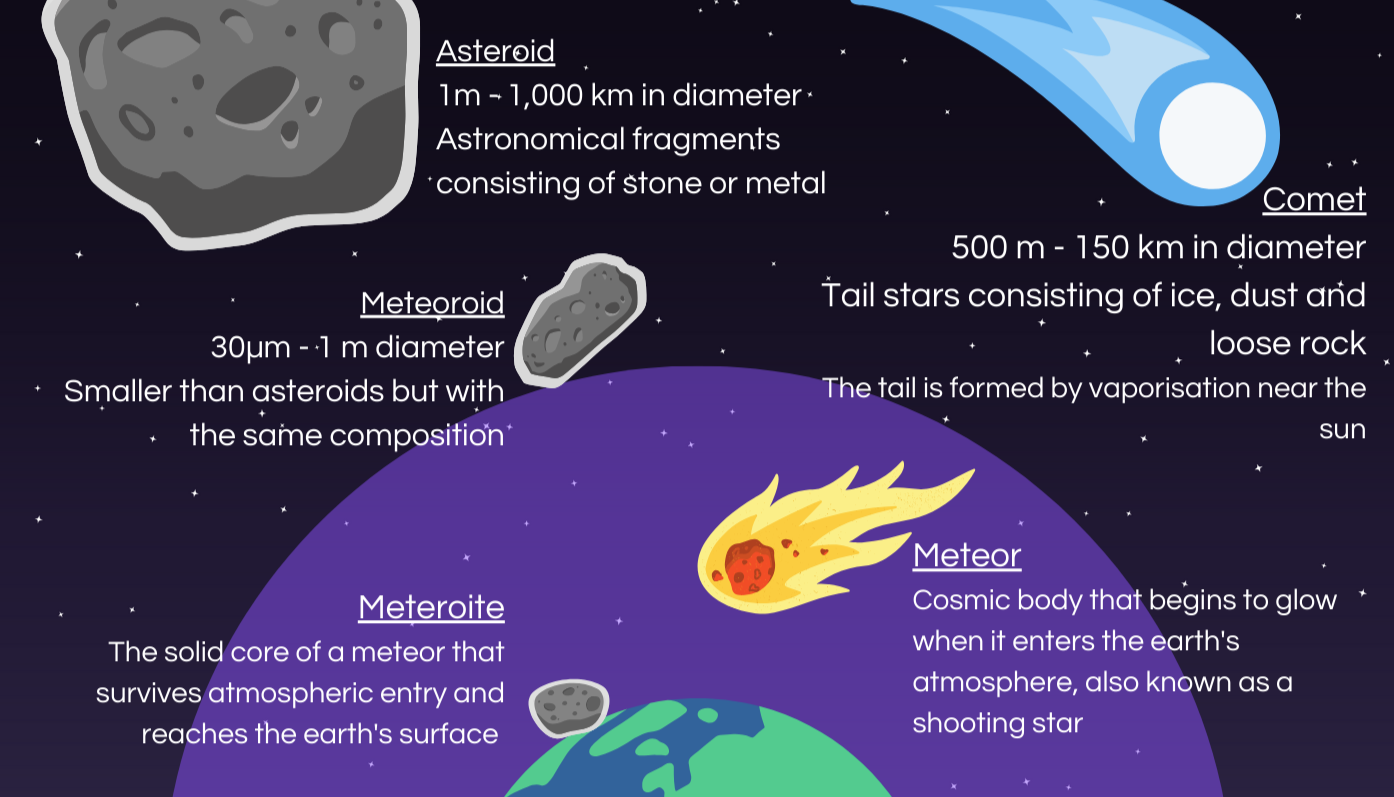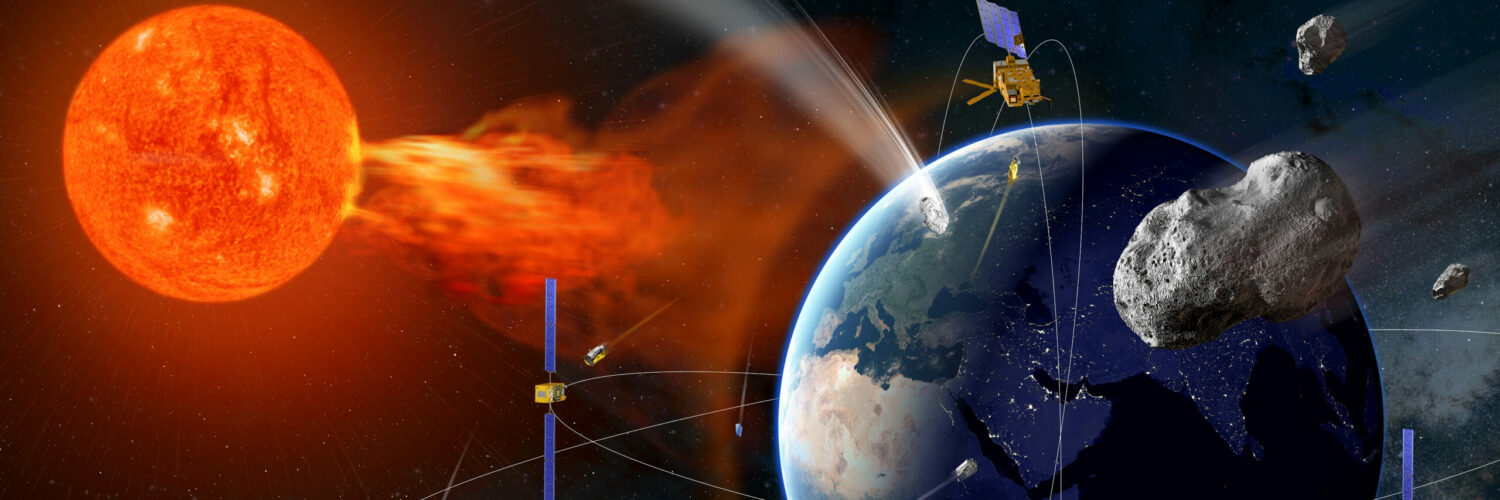SPACE HAZARDS
Solar storms, asteroids and space debris – these are all dangers from outer space. This topic page provides an overview of the various space hazards and other useful information.
©ESA 2019
What is space weather?
The Earth is part of an open system that constantly exchanges matter and energy with the sun and space. The sun is the main factor for space weather, as it generates energy through nuclear fusion, which is permanently emitted as electromagnetic radiation, also known as solar wind. The solar wind contributes to the warming of the Earth’s surface, whereby the radiation that is harmful to humans is largely shielded by the Earth’s magnetic field and the atmosphere. Solar flares and coronal mass ejections are irregular phenomena that can significantly influence the intensity of the solar wind. These variations in the solar wind in near-Earth space are known as space weather (Kusserow, U. & Marsch, E. 2023).
Solar storms caused by solar flares pose a sudden and direct danger. Modern infrastructure is susceptible to such disruptions due to its high level of complexity and dependence on electricity (Lovett, R. 2011). Space weather therefore affects the performance and reliability of many technical systems both in space and on Earth and can therefore indirectly jeopardise human lives (Vermicelli, P., et. al. 2022).Severe geomagnetic storms pose an additional risk to the power grid and long submarine cables. Electrically charged particles hitting the earth can cause voltage spikes in power grids and lead to the destruction of transformers, internet repeaters and submarine cables. Due to their dependence on electricity and the internet, telecommunication and transport systems as well as the health and financial sectors, for example, are affected (Abdu Jyothi, S. 2021).
The Carrington Event 1859
Date: September, 1. 1859
Discovered by: Richard Carrington
A solar flare caused an intense solar storm that hit the Earth directly and had global repercussions. For example, the northern lights appeared and could be seen as far away as the equator. The technologies of the time were severely impaired, especially telegraph systems, which suffered failures and even occasional fires. Meanwhile, light bulbs lit up without a power supply. Other power-operated technologies were not widespread at the time. It is hard to imagine what impact an event of this magnitude would have on our current technology system.
Dobrijevic, D. und May, A. (2022). „The Carrington Event: History’s greatest solar storm“
Space weather phenomena
Solar Wind
Continuous stream of charged particles generated by nuclear fusion and emitted from the sun in all directions in space.
Sunspots
Dark, cool areas on the surface of the sun are caused by strong magnetic fields and occur cyclically in connection with solar activity.
Solar flares
The sudden release of large quantities of high-energy particles and electromagnetic radiation from the surface of the sun results from restructuring processes in the solar magnetic field.
Coronal mass ejection
Plasma cloud of charged particles that can arise during a solar flare and, when it reaches the Earth, has an effect on the magnetosphere (geomagnetic storm) and the ionosphere (ionospheric storm).
Aurora (Northern Lights)
The interaction of charged particles with the Earth’s magnetic field can produce bright colours in the sky starting from the poles. During extreme solar storms, the aurora can be visible as far as the equator.
Asteroids, meteoroids and comets

Figure 1: Different types of space rock. | Source: Own illustration based on ESA
Meteor of Tscheljabinsk
Date: 15. Februar 2013
Where: Tscheljabinsk, Sibirien, Russland
A small asteroid with a diameter of around 20 metres unexpectedly entered the atmosphere over Chelyabinsk at a speed of 19.2 km/s and exploded around 20-40 km above the Earth’s surface. The explosion released the energy of around 500 kilotonnes of TNT. The resulting shock wave damaged around 7,000 buildings. As a result, 1,500 people were injured by flying splinters and shards of glass, but no one was killed.
Gaida, M. (2023): „Vor zehn Jahren: der Meteoritenfall von Tscheljabinsk“
Space rocks are probably the most widely recognised space hazard.Major events such as the impact of the Chicxulub asteroid around 66 million years ago, which caused the extinction of the dinosaurs, are very rare and occur on average only every 30 million years (Lingenhöhl, D. 2022).However, hundreds of smaller metre periods hit the Earth every day, most of which burn up as shooting stars and therefore pose no danger.Depending on the entry conditions, however, even smaller space objects with a diameter of only a few metres can cause considerable damage on Earth at orbital speeds of 10-72 km/s (Robert, L. 2024).
The majority of asteroids in our solar system are located in the asteroid belt between Mars and Jupiter and pose no danger to Earth.However, some asteroids can be thrown out of their normal orbit by collisions or gravity and set off on a collision course with the Earth.Such objects, along with near-Earth comets, are classified as Near Earth Objects (NEO) and monitored if they are within 0.3 AU (44,879,361 km) of Earth’s orbit (CNEOS 2024).In February 2024, around 34,500 Near Earth Asteroids (NEA) and around 100 Near Earth Comets (NEC) were known. NASA estimates that 90% of NEA with a diameter of more than 1 km have already been identified, but almost 90% of the expected small NEA (diameter < 10 m) are still undiscovered (CNEOS 2012).
Space Debris
Space debris includes all man-made objects, including fragments and elements thereof, that are either in orbit or briefly enter the atmosphere but are non-functional. These objects pose a threat to active satellites and terrestrial infrastructure, especially upon re-entry into the atmosphere.
Video 1: Debris in motion | Source: ARES 2019
There are currently around 34,000 monitored objects in our orbit, of which only 25% are active satellites, and less than a third of these are functional. Around 85% of the functional satellites are in Low Earth Orbits (LEO), which are up to 2,000 km above sea level and are economically valuable. Well-known satellites such as the International Space Station (~400 km) or the Starlink constellation (~550 km) are also located in these orbits. The remaining monitored objects are space debris. It is estimated that there are about 130 million more pieces in orbit that are too small (<10 cm) to be monitored. Despite their size, even small objects can cause major damage to satellites at orbital speeds of 25,000 km/h (ESA).
Sources of space debris
Satellites and spacecraft:
Accidental and intentional fragmentation in Earth orbit during launch and operation of launch vehicles and spacecraft.
Collisions and fragmentation:
Collisions between fragments or operational satellites. There have only been seven confirmed collisions so far, but this is expected to be a major source of space debris in the future. In particular, large satellite constellations, which are currently being proliferated by private companies, pose a significant risk of collision.
End of life satellites:
Satellites that are defective or at the end of their life remain in space and fall back to Earth within years to millennia. To date, non-functional satellites in low earth orbits (LEO) and geostationary orbits (GEO) must be removed from their original orbit within 25 years to avoid collisions.
Military activities:
Anti-satellite operations, where satellites are intentionally destroyed for military reasons, contribute massively to the creation of space debris. For example, the Chinese FengYun-1C mission in January 2007, a test anti-satellite mission, increased the number of trackable objects by 25 %.
Created: February 2024
Further links
DKKV
DKKV Newsletter
Current Information
No Results Found
The page you requested could not be found. Try refining your search, or use the navigation above to locate the post.


